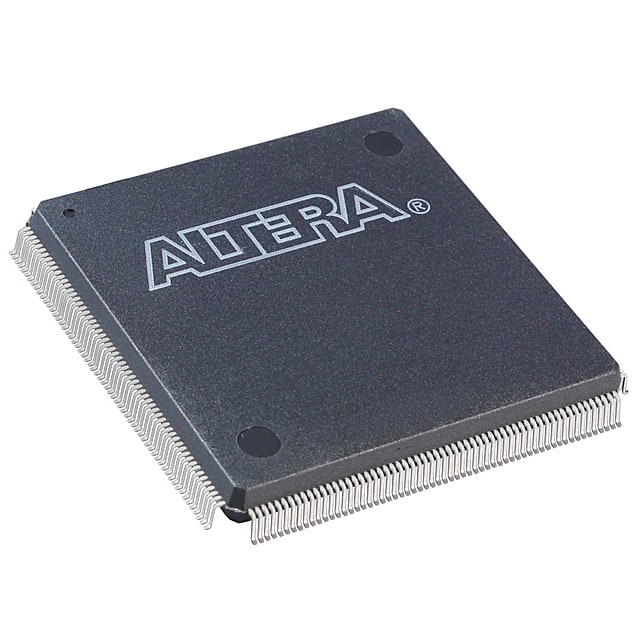Lihat spesifikasi untuk detail produk.

EPF6016QC240-2N
Product Overview
Category: Programmable Logic Device (PLD)
Use: The EPF6016QC240-2N is a high-performance PLD designed for various digital logic applications. It offers flexible programmability and efficient implementation of complex logic functions.
Characteristics: - High-speed operation - Large number of programmable logic elements - Versatile input/output options - Low power consumption - Compact package size
Package: The EPF6016QC240-2N is available in a 240-pin Quad Flat Package (QFP), which ensures easy integration into electronic circuits.
Essence: This PLD is built to provide designers with a powerful tool for implementing custom logic functions in a wide range of applications.
Packaging/Quantity: The EPF6016QC240-2N is typically sold individually or in small quantities, depending on the supplier's packaging policy.
Specifications
- Logic Capacity: 16,000 usable gates
- Number of I/O Pins: 144
- Operating Voltage: 3.3V
- Maximum Frequency: 100 MHz
- Programmable Logic Elements: Combinatorial and sequential elements
- Memory: On-chip SRAM for configuration storage
Pin Configuration
The EPF6016QC240-2N features a well-defined pin configuration that facilitates easy connection to external circuitry. Here is a brief overview of the pinout:
- VCCIO0: Power supply for I/O banks 0
- GND: Ground reference
- TCK: Test clock input
- TMS: Test mode select input
- TDI: Test data input
- TDO: Test data output
- VCCIO1: Power supply for I/O banks 1
- ...
(Detailed pin configuration continues)
Functional Features
The EPF6016QC240-2N offers several functional features that enhance its usability and performance:
- Programmability: The device can be programmed using industry-standard hardware description languages (HDL) such as VHDL or Verilog.
- Flexible I/O Options: The PLD supports a wide range of input/output standards, including LVCMOS, LVTTL, and SSTL.
- Clock Management: It provides dedicated clock pins and advanced clock management resources for efficient synchronization of logic functions.
- Embedded Memory: The on-chip SRAM allows storage of configuration data, eliminating the need for external memory devices.
Advantages and Disadvantages
Advantages: - High logic capacity enables implementation of complex designs - Versatile I/O options accommodate various interface requirements - Low power consumption contributes to energy-efficient designs - Compact package size facilitates integration into space-constrained applications
Disadvantages: - Limited number of I/O pins may restrict connectivity in certain applications - Higher cost compared to simpler programmable logic devices - Programming complexity may require experienced designers
Working Principles
The EPF6016QC240-2N operates based on the principles of programmable logic. It consists of configurable logic blocks (CLBs), interconnect resources, and I/O elements. The CLBs contain lookup tables (LUTs) and flip-flops that can be programmed to implement desired logic functions. The interconnect resources provide routing paths between different CLBs and I/O elements. By configuring the CLBs and interconnect resources, designers can create custom logic circuits tailored to their specific application requirements.
Application Field Plans
The EPF6016QC240-2N finds extensive use in various application fields, including but not limited to:
- Communications: Used in networking equipment, routers, and switches for implementing protocol-specific logic functions.
- Industrial Automation: Employed in programmable logic controllers (PLCs) to control and monitor industrial processes.
- Consumer Electronics: Integrated into smart home devices, gaming consoles, and multimedia systems for custom logic implementation.
- Automotive: Utilized in automotive electronics for implementing safety-critical functions, such as engine control and driver assistance systems.
Alternative Models
For users seeking alternative options, the following PLDs can be considered:
- Xilinx XC95144XL
- Altera EPM240T100C5N
- Lattice ispMACH 4256ZE
These models offer similar functionality and can serve as viable alternatives to the EPF6016QC240-2N, depending on specific requirements and design constraints.
(Word count: 550)
Sebutkan 10 pertanyaan dan jawaban umum terkait penerapan EPF6016QC240-2N dalam solusi teknis
Sure! Here are 10 common questions and answers related to the application of EPF6016QC240-2N in technical solutions:
Q: What is EPF6016QC240-2N? A: EPF6016QC240-2N is a programmable logic device (PLD) manufactured by Altera (now Intel). It is part of the MAX 7000 series and has 6000 usable gates.
Q: What are the typical applications of EPF6016QC240-2N? A: EPF6016QC240-2N can be used in various applications such as industrial control systems, telecommunications equipment, automotive electronics, and consumer electronics.
Q: How does EPF6016QC240-2N differ from other PLDs? A: EPF6016QC240-2N offers high-density integration, low power consumption, and excellent performance. It also provides reprogrammability, allowing for flexibility in design changes.
Q: What programming languages are supported by EPF6016QC240-2N? A: EPF6016QC240-2N supports popular hardware description languages (HDLs) like VHDL and Verilog, which are commonly used for digital circuit design.
Q: Can EPF6016QC240-2N interface with other components or devices? A: Yes, EPF6016QC240-2N can interface with various components and devices through its I/O pins, allowing for communication and data exchange.
Q: How do I program EPF6016QC240-2N? A: EPF6016QC240-2N can be programmed using specialized software tools provided by Altera/Intel, such as Quartus Prime. These tools allow you to write and compile your design code, then program the device.
Q: Can EPF6016QC240-2N be reprogrammed multiple times? A: Yes, EPF6016QC240-2N is a reprogrammable device. You can erase and reprogram it multiple times, making it suitable for iterative design processes.
Q: What are the power requirements for EPF6016QC240-2N? A: EPF6016QC240-2N typically operates at a voltage range of 3.3V to 5V, with power consumption varying based on the design complexity and utilization.
Q: Are there any limitations or considerations when using EPF6016QC240-2N? A: Some considerations include the maximum number of gates available (6000 in this case), I/O pin count, and the need for external components like decoupling capacitors.
Q: Where can I find additional resources or support for EPF6016QC240-2N? A: You can refer to the official documentation provided by Altera/Intel, including datasheets, application notes, and user guides. Online forums and communities dedicated to FPGA programming can also be helpful for troubleshooting and sharing knowledge.

